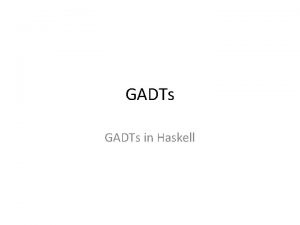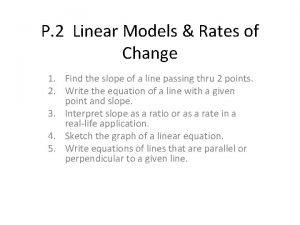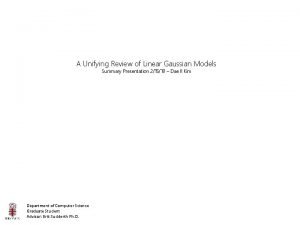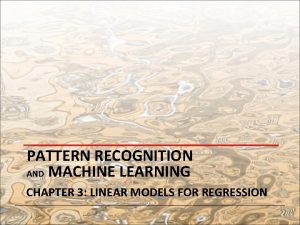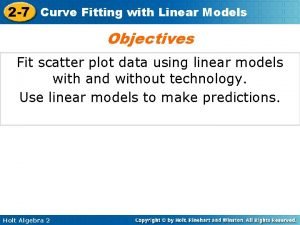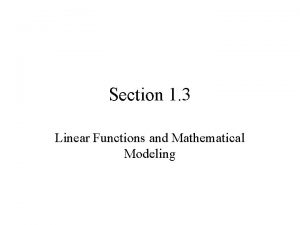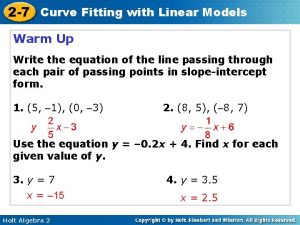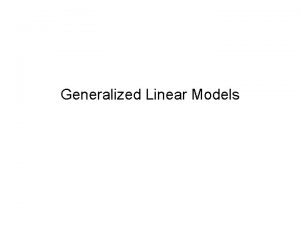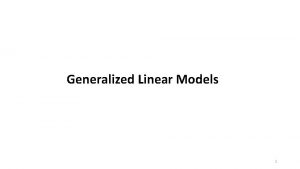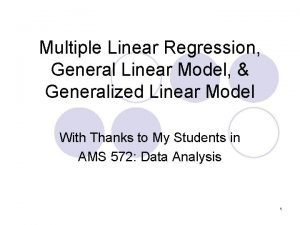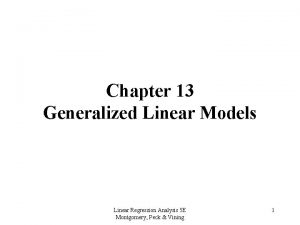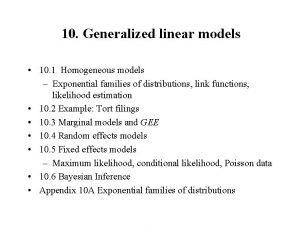Learn R Data Management Generalized Linear Models Nathaniel



![Recipe 1: Subset • object. to. subset[subset instructions] By index By name By logical Recipe 1: Subset • object. to. subset[subset instructions] By index By name By logical](https://slidetodoc.com/presentation_image_h2/2aa794abef48a2de70d4517b98027c34/image-4.jpg)
















- Slides: 20

Learn R! Data Management (& Generalized Linear Models) Nathaniel Mac. Hardy Fall 2014

Why care about data management? • Everything in R is technically data –“classic” data: tables –Model Results –Functions

Cooking with Data • Simple recipes we’ll learn today 1. Subset according to some rule 2. Code a variable into simpler categories 3. Merge data on a key value (ID) 4. Recode particular values of a variable
![Recipe 1 Subset object to subsetsubset instructions By index By name By logical Recipe 1: Subset • object. to. subset[subset instructions] By index By name By logical](https://slidetodoc.com/presentation_image_h2/2aa794abef48a2de70d4517b98027c34/image-4.jpg)
Recipe 1: Subset • object. to. subset[subset instructions] By index By name By logical By expression vector[ c(1, 2, 3) ] data [ 2, 4 ] data [ 3, ] data [ , 2 ] cars[ c(“speed”, ”dist”) ] (1: 3)[ c(TRUE, FALSE, TRUE) ] cars$dist[ cars$speed== 7]

Operators: Generate TRUE/FALSE • Feed these into square brackets! foods %in% c(“pizza”, ”pie”) age > 18 eyecolor == “red”

Basic Functions: Combine/Transform c() data. frame() rbind() merge() t() rows/columns combine bind into data frame stack data merge data by key swap

Functions II: Shortcuts values <- rep(1: 100, 3) # create some data # the long way to classify cat <- rep(NA, length(cat)) # empty vector cat[values<30] <- “high” cat[values>=30 & values<70] <- “medium” cat[values>=70] <- “high” table(cat) high low medium 90 90 120

Recipe 2: Classifying Data with Cut cat <- cut(values, c(0, 30, 70, 100)) table(cat) (0, 30] 90 (30, 70] 120 (70, 100] 90 cat <- cut(values, c(0, 30, 70, 100), labels=c(“low”, ”med”, ”high”)) # if desired

Recipe 3: Merge Data health <- data. frame( id=c(“a”, ”b”, ”c”), age=c(33, 56, 13) ) out <- data. frame( id=c(“b”, ”c”, ”a”), outcome=c(0, 0, 1)) merged <- merge(health, out, by=“id”)

Recipe 4: Replacing Data • What if you want to recode part of an object? • Easy: subset the “destination” of <x <- c(1, NA, 0, NA, 3, NA, 4, 6) # replace NA x[is. na(x)] <- 0 y <- c(1, 1, 4, 10, 99, 100) y[y>10] <- 10 # clip range

Part II: Generalized Linear Models

Why care about Generalized Linear Models (GLMs)? • Almost all Epi models are GLMs –Odds ratios (logistic) –Risk ratios (log-binomial) –“Fancy” models are usually just extensions of GLMs � GWR (geographically weighted regression) adds a “weights matrix” � MCMC (Markov Chain Monte Carlo) solves GLMs with priors

Basic Parts of GLMs

Specifying a model in R

Example: Using glm() � data(CO 2); attach(CO 2) � glm(uptake ~ Type) � Call: glm(formula = uptake ~ Type) � Coefficients: � (Intercept) Type. Mississippi � 33. 54 -12. 66 � Degrees of Freedom: 83 Total (i. e. Null); 82 Residual � Null Deviance: 9707 � Residual Deviance: 6341 AIC: 607. 6

Example: Using glm() � data(CO 2); attach(CO 2) � glm(uptake ~ type + conc) � Call: glm(formula = uptake ~ Type + conc) � Coefficients: � (Intercept) Type. Mississippi conc � 25. 83005 -12. 65952 0. 01773 � Degrees of Freedom: 83 Total (i. e. Null); 81 Residual � Null Deviance: 9707 � Residual Deviance: 4056 AIC: 572. 1

More info: glm() object � m 1 <- glm(uptake ~ type + conc) ummary(m 1) oefficients: Estimate ntercept) 25. 830052 Mississippi -12. 659524 onc 0. 017731 Std. Error t value Pr(>|t|) 1. 579918 16. 349 < 2 e-16 *** 1. 544261 -8. 198 3. 06 e-12 *** 0. 002625 6. 755 2. 00 e-09 *** ignif. codes: 0 ‘***’ 0. 001 ‘**’ 0. 01 ‘*’ 0. 05 ‘. ’ 0. 1 ‘ ’ 1

More info: glm() object > confint(m 1) Waiting for profiling to be done. . . 2. 5 % 97. 5 % (Intercept) 22. 7334700 28. 92663347 Type. Mississippi -15. 6862201 -9. 63282749 conc 0. 0125859 0. 02287528

Getting Epidemiological Measures • Specify the family argument � glm(y~x) # default linear, risk difference � glm(y~x, family=binomial(“log”) # risk ratio � glm(y~x, family=binomial(“logit”) # odds ratio � For odds ratio and risk ratio, make sure to exponentiate the output wi exp() first � R gives you the beta coefficient �

Lab: Practice with GLMs • You'll learn more about model-building in courses � What goes in the model (confounders) � Choosing a “best” model • Practice data management � Preparing data for analyses � Formatting/extracting results �
 Kinesthetic learners learn best by
Kinesthetic learners learn best by Generalized linear phase system
Generalized linear phase system Sas generalized linear model
Sas generalized linear model Avl tree haskell
Avl tree haskell What is the difference between modals and semi modals
What is the difference between modals and semi modals Linear view of communication
Linear view of communication Glatthorn model of curriculum
Glatthorn model of curriculum Linear models and rates of change
Linear models and rates of change Transactional model
Transactional model A unifying review of linear gaussian models
A unifying review of linear gaussian models Linear basis function models
Linear basis function models Subcripted
Subcripted Qm for windows
Qm for windows Curve fitting with linear models
Curve fitting with linear models Linear functions as mathematical models
Linear functions as mathematical models Linear quadratic and exponential graphs
Linear quadratic and exponential graphs Linear functions as mathematical models
Linear functions as mathematical models Curve fitting with linear models
Curve fitting with linear models Ribbon symbolism literature
Ribbon symbolism literature Nathaniel hawthorne middle school 74
Nathaniel hawthorne middle school 74 Summary of the
Summary of the



